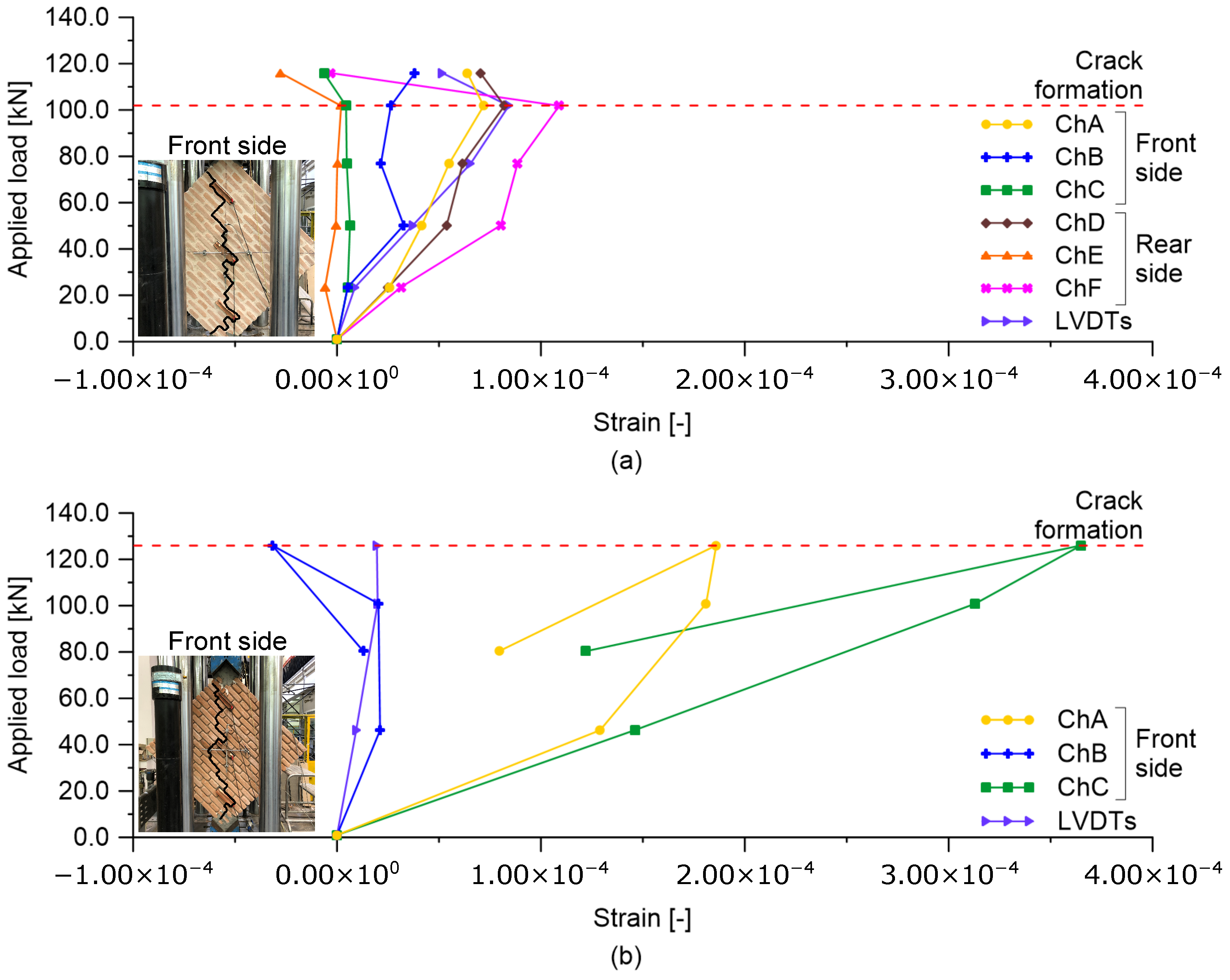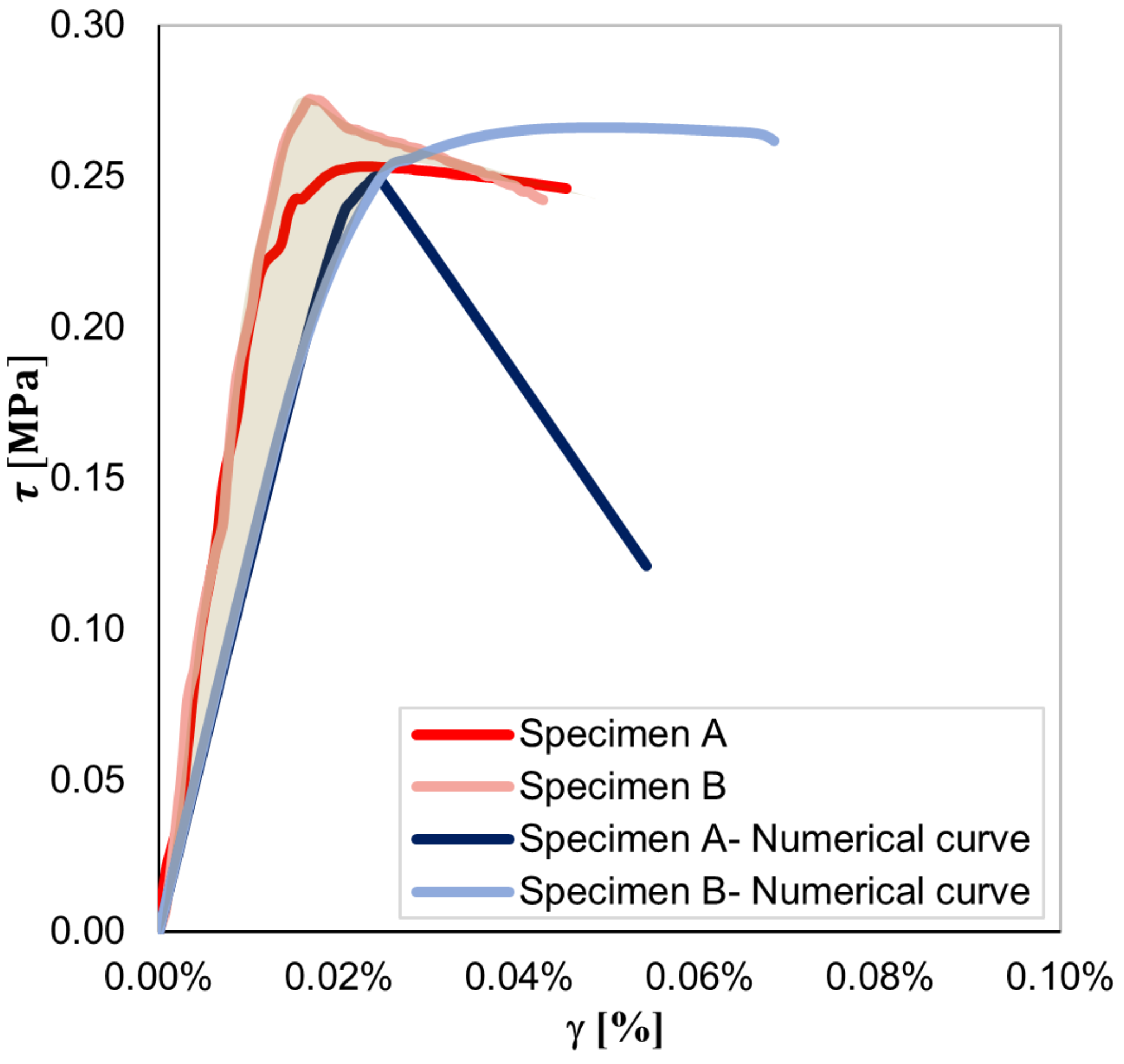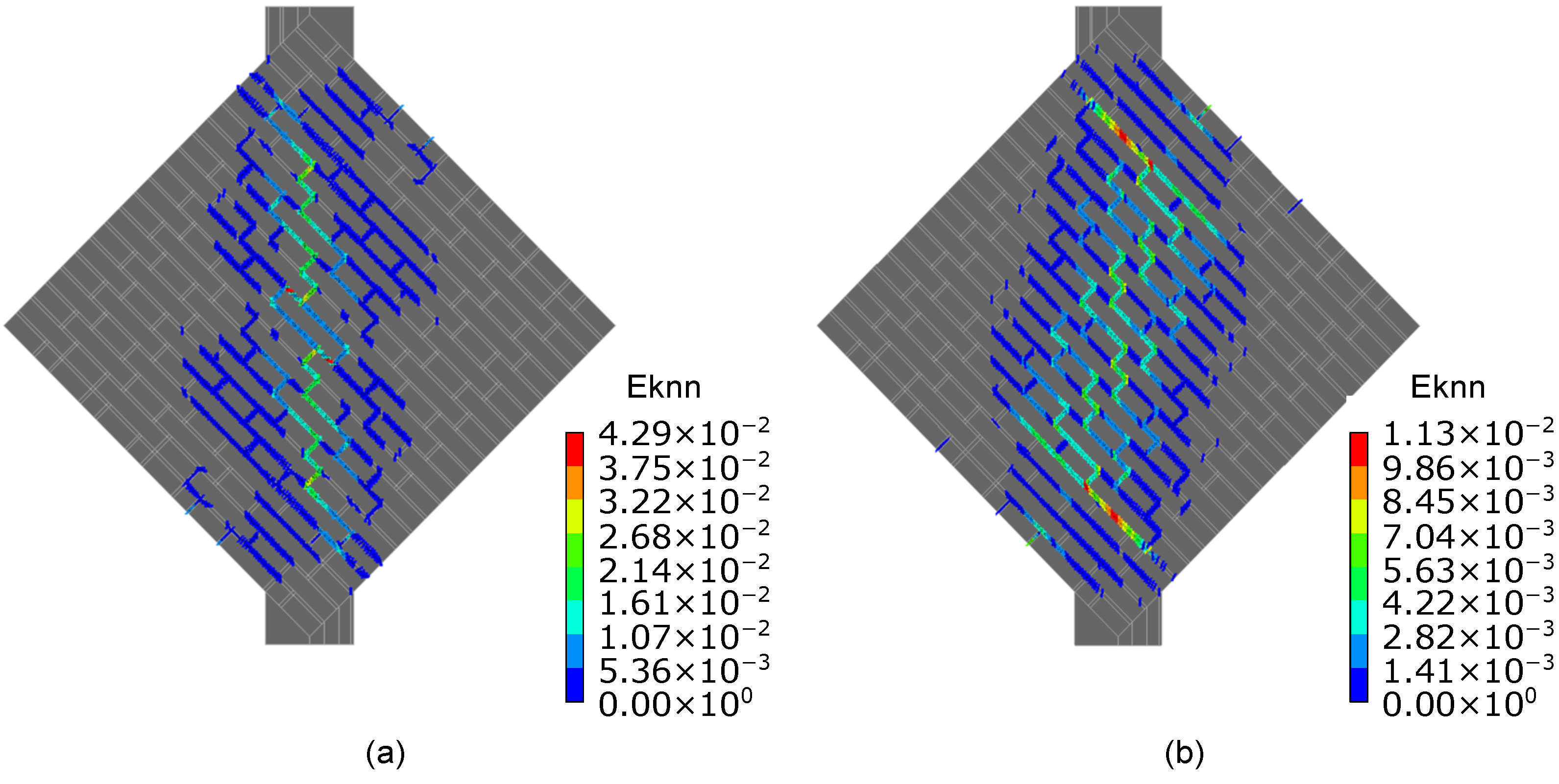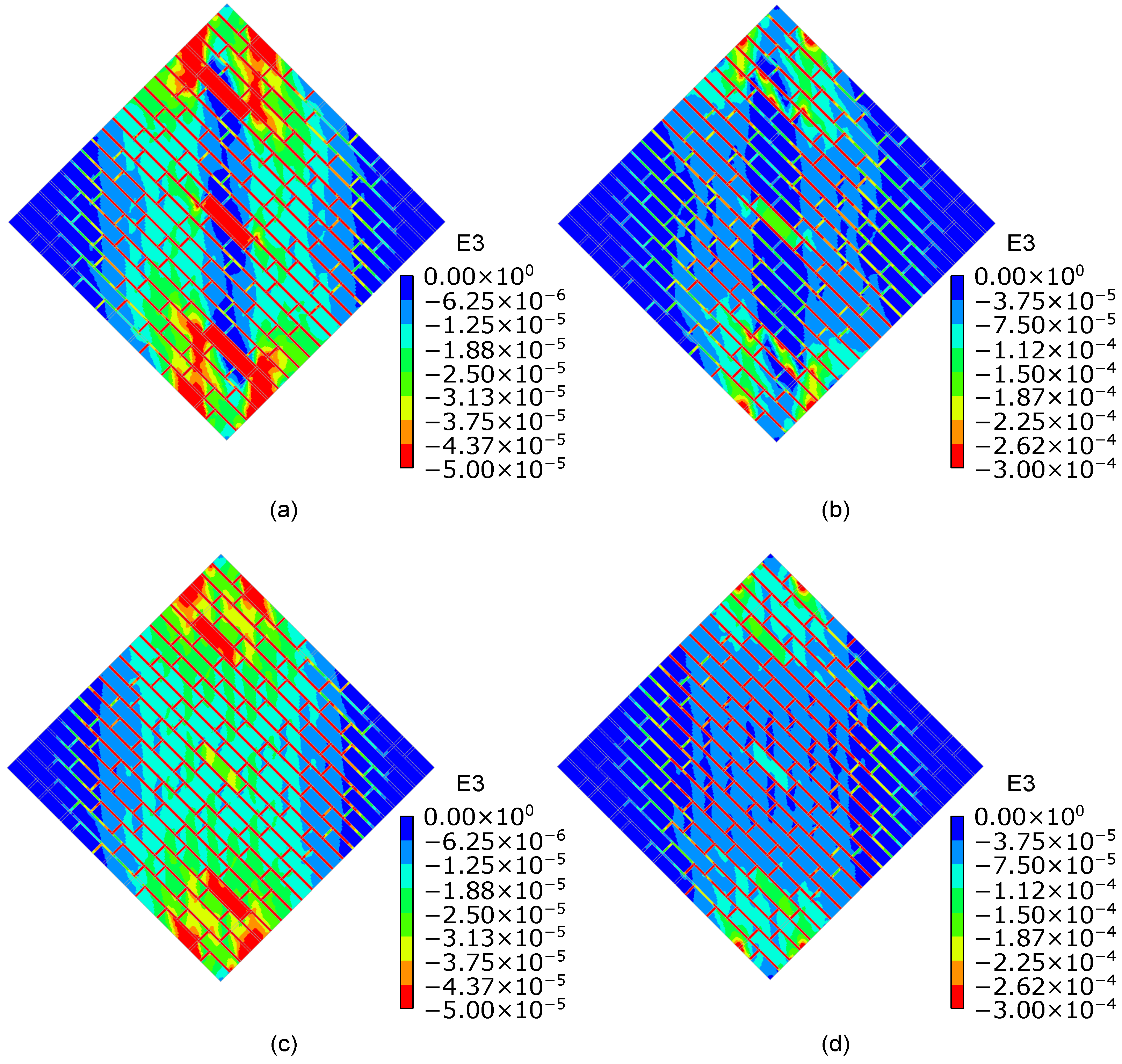Strain Monitoring and Crack Detection in Masonry Walls under In-Plane Shear Loading Using Smart Bricks: First Results from Experimental Tests and Numerical Simulations †
Abstract
:1. Introduction
2. Smart Bricks
2.1. Basic Sensing Principle
2.2. Materials and Preparation
2.3. Electromechanical Model of Smart Bricks
3. Experimental Application
3.1. Masonry Wall Specimens
3.2. Diagonal Compression Tests
4. Numerical Simulations
5. Results
5.1. Experimental Application
5.2. Numerical Simulations
6. Discussion
7. Conclusions
Author Contributions
Funding
Institutional Review Board Statement
Informed Consent Statement
Data Availability Statement
Conflicts of Interest
References
- Glisic, B.; Hubbell, D.L.; Sigurdardottir, D.H.; Yao, Y. Damage detection and characterization using long-gauge and distributed fiber optic sensors. Opt. Eng. 2013, 52, 087101. [Google Scholar] [CrossRef]
- Han, B.; Ding, S.; Yu, X. Intrinsic self-sensing concrete and structures: A review. Measurement 2015, 59, 110–128. [Google Scholar] [CrossRef]
- Ascione, F.; Ceroni, F.; De Masi, R.F.; de’Rossi, F.; Pecce, M.R. Historical buildings: Multidisciplinary approach to structural/energy diagnosis and performance assessment. Appl. Energy 2017, 185, 1517–1528. [Google Scholar] [CrossRef]
- Masciotta, M.G.; Pellegrini, D.; Brigante, D.; Barontini, A.; Lourenço, P.B.; Girardi, M.; Padovani, C.; Fabbrocino, G. Dynamic characterization of progressively damaged segmental masonry arches with one settled support: Experimental and numerical analyses. Frat. Integrita Strutt. 2020, 14, 423–441. [Google Scholar] [CrossRef]
- Augenti, N.; Parisi, F. Learning from construction failures due to the 2009 L’Aquila, Italy, earthquake. J. Perform. Constr. Facil. 2010, 24, 536–555. [Google Scholar] [CrossRef]
- Parisi, F.; Lignola, G.P.; Augenti, N.; Prota, A.; Manfredi, G. Rocking response assessment of in-plane laterally-loaded masonry walls with openings. Eng. Struct. 2013, 56, 1234–1248. [Google Scholar] [CrossRef]
- Saisi, A.; Gentile, C.; Ruccolo, A. Continuous monitoring of a challenging heritage tower in Monza, Italy. J. Civ. Struct. Health Monit. 2018, 8, 77–90. [Google Scholar] [CrossRef]
- Parisi, F.; Augenti, N. Earthquake damages to cultural heritage constructions and simplified assessment of artworks. Eng. Fail. Anal. 2013, 34, 735–760. [Google Scholar] [CrossRef]
- Fiorentino, G.; Forte, A.; Pagano, E.; Sabetta, F.; Baggio, C.; Lavorato, D.; Nuti, C.; Santini, S. Damage patterns in the town of Amatrice after August 24th 2016 Central Italy earthquakes. Bull. Earthq. Eng. 2018, 16, 1399–1423. [Google Scholar] [CrossRef] [Green Version]
- Dolce, M.; Prota, A.; Borzi, B.; da Porto, F.; Lagomarsino, S.; Magenes, G.; Moroni, C.; Penna, A.; Polese, M.; Speranza, E.; et al. Seismic risk assessment of residential buildings in Italy. Bull. Earthq. Eng. 2021, 19, 2999–3032. [Google Scholar] [CrossRef]
- Ludeno, G.; Cavalagli, N.; Ubertini, F.; Soldovieri, F.; Catapano, I. On the combined use of ground penetrating radar and crack meter sensors for structural monitoring: Application to the historical Consoli Palace in Gubbio, Italy. Surv. Geophys. 2020, 41, 647–667. [Google Scholar] [CrossRef] [Green Version]
- García-Macías, E.; Ubertini, F. Least Angle Regression for early-stage identification of earthquake-induced damage in a monumental masonry palace: Palazzo dei Consoli. Eng. Struct. 2022, 259, 114119. [Google Scholar] [CrossRef]
- Ivorra, S.; Pallarés, F.J. Dynamic investigations on a masonry bell tower. Eng. Struct. 2006, 28, 660–667. [Google Scholar] [CrossRef]
- Gentile, C.; Saisi, A. Ambient vibration testing of historic masonry towers for structural identification and damage assessment. Constr. Build. Mater. 2007, 21, 1311–1321. [Google Scholar] [CrossRef]
- Ramos, L.F.; Masciotta, M.; Lourenço, P.B.; Vasta, M. SHM of a masonry chimney after a lightning accident. In Proceedings of the 9th International Workshop on Structural Health Monitoring, Dohrmann Grove, CA, USA, 10–12 September 2013. [Google Scholar]
- Formisano, A.; Di Lorenzo, G.; Krstevska, L.; Landolfo, R. Fem model calibration of experimental environmental vibration tests on two churches hit by L’Aquila earthquake. Int. J. Archit. Herit. 2021, 15, 113–131. [Google Scholar] [CrossRef]
- Ashayeri, I.; Biglari, M.; Formisano, A.; D’Amato, M. Ambient vibration testing and empirical relation for natural period of historical mosques. Case study of eight mosques in Kermanshah, Iran. Constr. Build. Mater. 2021, 289, 123191. [Google Scholar] [CrossRef]
- Ahmadi, S.S.; Karanikoloudis, G.; Mendes, N.; Illambas, R.; Lourenço, P.B. Appraising the Seismic Response of a Retrofitted Adobe Historic Structure, the Role of Modal Updating and Advanced Computations. Buildings 2022, 12, 1795. [Google Scholar] [CrossRef]
- Civera, M.; Mugnaini, V.; Zanotti Fragonara, L. Machine learning-based automatic operational modal analysis: A structural health monitoring application to masonry arch bridges. Struct. Control. Health Monit. 2022, 29, e3028. [Google Scholar] [CrossRef]
- Shimpi, V.; Sivasubramanian, M.V.; Singh, S. Present day status and numerical modelling of heritage masonry bridges of Kalka-Shimla Mountain Railways. Int. J. Mason. Res. Innov. 2022, 7, 266–280. [Google Scholar] [CrossRef]
- Borlenghi, P.; Saisi, A.; Gentile, C. ND testing and establishing models of a multi-span masonry arch bridge. J. Civ. Struct. Health Monit. 2023, 1–17. [Google Scholar] [CrossRef]
- Derakhshan, H.; Visintin, P.; Griffith, M.C. Case studies of material properties of late nineteenth-century unreinforced masonry buildings in Adelaide. Aust. J. Civ. Eng. 2017, 15, 109–116. [Google Scholar] [CrossRef] [Green Version]
- Acikgoz, S.; Luciano, A.; Dewhirst, M.; Dejong, M.J.; Mair, R. Innovative monitoring of the response of a heritage masonry building to nearby tunnelling in London Clay. Géotechnique 2022, 72, 200–215. [Google Scholar] [CrossRef]
- Nalon, G.H.; Ribeiro, J.C.L.; Pedroti, L.G.; da Silva, R.M.; de Araújo, E.N.D.; Santos, R.F.; de Lima, G.E.S. Review of recent progress on the compressive behavior of masonry prisms. Constr. Build. Mater. 2022, 320, 126181. [Google Scholar] [CrossRef]
- Dalgic, K.D.; Gulen, B.; Liu, Y.; Acikgoz, S.; Burd, H.; Marasli, M.; Ilki, A. Masonry buildings subjected to settlements: Half-scale testing, detailed measurements, and insights into behaviour. Eng. Struct. 2023, 278, 115233. [Google Scholar] [CrossRef]
- Pascariello, M.N.; Luciano, A.; Bilotta, E.; Acikgoz, S.; Mair, R. Numerical modelling of the response of two heritage masonry buildings to nearby tunnelling. Tunn. Undergr. Space Technol. 2023, 131, 104845. [Google Scholar] [CrossRef]
- Tang, Y.; Chen, M.; Lin, Y.; Huang, X.; Huang, K.; He, Y.; Li, L. Vision-based three-dimensional reconstruction and monitoring of large-scale steel tubular structures. Adv. Civ. Eng. 2020, 2020, 1–17. [Google Scholar] [CrossRef]
- Shamsabadi, E.A.; Xu, C.; Dias-da Costa, D. Robust crack detection in masonry structures with Transformers. Measurement 2022, 200, 111590. [Google Scholar] [CrossRef]
- Mousavi, M.; Bakhshi, A. Crack detection in masonry structures using computer vision based on deep learning. Sharif J. Civ. Eng. 2022, 38, 99–108. [Google Scholar]
- Sangirardi, M.; Altomare, V.; De Santis, S.; de Felice, G. Detecting damage evolution of masonry structures through computer-vision-based monitoring methods. Buildings 2022, 12, 831. [Google Scholar] [CrossRef]
- Tang, Y.; Zhu, M.; Chen, Z.; Wu, C.; Chen, B.; Li, C.; Li, L. Seismic performance evaluation of recycled aggregate concrete-filled steel tubular columns with field strain detected via a novel mark-free vision method. Structures 2022, 37, 426–441. [Google Scholar] [CrossRef]
- Que, Y.; Dai, Y.; Ji, X.; Leung, A.K.; Chen, Z.; Tang, Y.; Jiang, Z. Automatic classification of asphalt pavement cracks using a novel integrated generative adversarial networks and improved VGG model. Eng. Struct. 2023, 277, 115406. [Google Scholar] [CrossRef]
- Valvona, F.; Toti, J.; Gattulli, V.; Potenza, F. Effective seismic strengthening and monitoring of a masonry vault by using Glass Fiber Reinforced Cementitious Matrix with embedded Fiber Bragg Grating sensors. Compos. Part B Eng. 2017, 113, 355–370. [Google Scholar] [CrossRef]
- Verstrynge, E.; De Wilder, K.; Drougkas, A.; Voet, E.; Van Balen, K.; Wevers, M. Crack monitoring in historical masonry with distributed strain and acoustic emission sensing techniques. Constr. Build. Mater. 2018, 162, 898–907. [Google Scholar] [CrossRef]
- Barsocchi, P.; Bartoli, G.; Betti, M.; Girardi, M.; Mammolito, S.; Pellegrini, D.; Zini, G. Wireless sensor networks for continuous structural health monitoring of historic masonry towers. Int. J. Archit. Herit. 2021, 15, 22–44. [Google Scholar] [CrossRef]
- Downey, A.; D’Alessandro, A.; Laflamme, S.; Ubertini, F. Smart bricks for strain sensing and crack detection in masonry structures. Smart Mater. Struct. 2017, 27, 015009. [Google Scholar] [CrossRef] [Green Version]
- García-Macías, E.; Ubertini, F. Earthquake-induced damage detection and localization in masonry structures using smart bricks and Kriging strain reconstruction: A numerical study. Earthq. Eng. Struct. Dyn. 2019, 48, 548–569. [Google Scholar] [CrossRef]
- Meoni, A.; D’Alessandro, A.; Ubertini, F. Characterization of the strain-sensing behavior of smart bricks: A new theoretical model and its application for monitoring of masonry structural elements. Constr. Build. Mater. 2020, 250, 118907. [Google Scholar] [CrossRef]
- Meoni, A.; D’Alessandro, A.; Cavalagli, N.; Gioffré, M.; Ubertini, F. Shaking table tests on a masonry building monitored using smart bricks: Damage detection and localization. Earthq. Eng. Struct. Dyn. 2019, 48, 910–928. [Google Scholar] [CrossRef]
- Meoni, A.; D’Alessandro, A.; Kruse, R.; De Lorenzis, L.; Ubertini, F. Strain field reconstruction and damage identification in masonry walls under in-plane loading using dense sensor networks of smart bricks: Experiments and simulations. Eng. Struct. 2021, 239, 112199. [Google Scholar] [CrossRef]
- Meoni, A.; Fabiani, C.; D’Alessandro, A.; Pisello, A.; Ubertini, F. Strain-sensing smart bricks under dynamic environmental conditions: Experimental investigation and new modeling. Constr. Build. Mater. 2022, 336, 127375. [Google Scholar] [CrossRef]
- D’Alessandro, A.; Meoni, A.; Ubertini, F. Stainless Steel Microfibers for Strain-Sensing Smart Clay Bricks. J. Sens. 2018, 2018, 8. [Google Scholar] [CrossRef]
- Corradi, M.; Borri, A.; Vignoli, A. Experimental study on the determination of strength of masonry walls. Constr. Build. Mater. 2003, 17, 325–337. [Google Scholar] [CrossRef]
- Borri, A.; Castori, G.; Corradi, M. Determination of shear strength of masonry panels through different tests. Int. J. Archit. Herit. 2015, 9, 913–927. [Google Scholar] [CrossRef]
- Celano, T.; Ceroni, F.; Lignola, G.P. Behaviour of masonry walls strengthened with fibre-reinforced cementitious materials. Eng. Comput. Mech. 2021, 174, 193–214. [Google Scholar] [CrossRef]
- Meoni, A.; D’Alessandro, A.; Mancinelli, M.; Ubertini, F. A Multichannel Strain Measurement Technique for Nanomodified Smart Cement-Based Sensors in Reinforced Concrete Structures. Sensors 2021, 21, 5633. [Google Scholar] [CrossRef]
- Downey, A.; D’Alessandro, A.; Ubertini, F.; Laflamme, S.; Geiger, R. Biphasic DC measurement approach for enhanced measurement stability and multi-channel sampling of self-sensing multi-functional structural materials doped with carbon-based additives. Smart Mater. Struct. 2017, 26, 6. [Google Scholar] [CrossRef] [Green Version]
- Chai, S. Finite Element Analysis for Civil Engineering with DIANA Software; Springer Nature Singapore Pte. Ltd.: Singapore, 2020. [Google Scholar]
- Hordijk, D.A. Local Approach to Fatigue of Concrete. Ph.D. Thesis, Delft University of Technology, Delft, The Netherlands, 1991. [Google Scholar]
- Lignola, G.P.; Prota, A.; Manfredi, G. Nonlinear analyses of tuff masonry walls strengthened with cementitious matrix-grid composites. J. Compos. Constr. 2009, 13, 243–251. [Google Scholar] [CrossRef]
- Mininno, G.; Ghiassi, B.; Oliveira, D.V. Modelling of the in-plane and out-of-plane performance of TRM-strengthened masonry walls. Key Eng. Mater. 2017, 747, 60–68. [Google Scholar] [CrossRef]
- Lourenço, P.B. Recent advances in masonry modelling: Micromodelling and homogenisation. Multiscale Model. Solid Mech. Comput. Approaches 2010, 251–294. [Google Scholar] [CrossRef] [Green Version]









| [] | b | |||
|---|---|---|---|---|
| Smart bricks | 19.6 | 2.16 | 1603 |
| Material | E [MPa] | [MPa] | [MPa] | [Nmm] | [Nmm] | v [-] |
|---|---|---|---|---|---|---|
| Brick | 13000 | 20.79 | 5.90 | 0.2 | ||
| Mortar | 1500 | 2.52 | 0.77 | 0.2 |
Disclaimer/Publisher’s Note: The statements, opinions and data contained in all publications are solely those of the individual author(s) and contributor(s) and not of MDPI and/or the editor(s). MDPI and/or the editor(s) disclaim responsibility for any injury to people or property resulting from any ideas, methods, instructions or products referred to in the content. |
© 2023 by the authors. Licensee MDPI, Basel, Switzerland. This article is an open access article distributed under the terms and conditions of the Creative Commons Attribution (CC BY) license (https://creativecommons.org/licenses/by/4.0/).
Share and Cite
Meoni, A.; D’Alessandro, A.; Saviano, F.; Lignola, G.P.; Parisi, F.; Ubertini, F. Strain Monitoring and Crack Detection in Masonry Walls under In-Plane Shear Loading Using Smart Bricks: First Results from Experimental Tests and Numerical Simulations. Sensors 2023, 23, 2211. https://doi.org/10.3390/s23042211
Meoni A, D’Alessandro A, Saviano F, Lignola GP, Parisi F, Ubertini F. Strain Monitoring and Crack Detection in Masonry Walls under In-Plane Shear Loading Using Smart Bricks: First Results from Experimental Tests and Numerical Simulations. Sensors. 2023; 23(4):2211. https://doi.org/10.3390/s23042211
Chicago/Turabian StyleMeoni, Andrea, Antonella D’Alessandro, Felice Saviano, Gian Piero Lignola, Fulvio Parisi, and Filippo Ubertini. 2023. "Strain Monitoring and Crack Detection in Masonry Walls under In-Plane Shear Loading Using Smart Bricks: First Results from Experimental Tests and Numerical Simulations" Sensors 23, no. 4: 2211. https://doi.org/10.3390/s23042211









